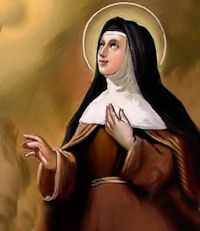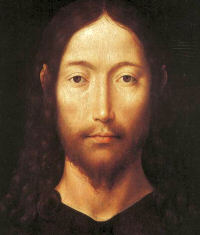Lent: March 6th
Wednesday of the Third Week of Lent
Other Commemorations: St. Colette, Virgin and Religious (RM)
» Enjoy our Liturgical Seasons series of e-books!
Today we have a venerable Lenten Mass. This Mass is best understood by remembering that the ancient catechumens (or prospective converts) used to come for instructions to the first part of Lenten Masses. The catechumens heard the readings and homily, and then left the church. The offertory procession and remainder of the Mass were for the faithful. This Wednesday was the first “scrutiny,” or test, for the catechumens. That test was on the Commandments of God. Both readings, consequently, are about the Commandments. —The Vatican II Weekday Missal
The Roman Martyrology commemorates St. Colette (1381-1447), who revived the Franciscan spirit among the Poor Clares. Her reform spread throughout France, Savoy, Germany, and Flanders, many convents being restored and seventeen new ones founded by her. She helped St. Vincent Ferrer in the work of healing the papal schism.
Meditation—Obedient Unto Death
This we have frequently heard and have often meditated upon — but have we conformed our lives to this model so worthy of imitation? Must we not confess that we strive often to appear superior in our natural and spiritual talents? Do we not all too frequently boast of our accomplishment as if no one had ever equalled us? Does not history show how man in his pride has exceeded al bounds, seeking to place himself on a level with — and at times even above — Almighty God?
Yet Christ, Who was true God, "emptied Himself, taking the nature of a slave and being made like unto men, and appearing in the form of man, He humbled Himself, becoming obedient to death, even to the death of the Cross" (Phil. 2:7). It is precisely in this deep humiliation that He wishes to continue dwelling among us. Every Crucifix tells us this: "Learn of Me, for I am meek and humble of heart…I have been obedient unto death. . . I am full of love and patience."
Most of us will go to any lengths to cancel our degradation from our fellow men, while trying to give others the most favorable possible impression of ourselves. King Agesilaus of Sparta was a most excellent ruler, celebrated for his justice and wisdom, but he was most unattractive physically. At his death, he strictly forbade any portrait to be made of himself, whether painted or sculptured. The king feared lest such a visible remembrance of him might lessen the love and esteems which he had gained among his people during his lifetime because of his just and wise rule.
But the Son of God did not fear to approach us in His deepest humiliation and ignominy. He displays Himself to us in all His woe, summoning us to contemplate Him as the Man of Sorrows, asking that we grow in humility and patience by studying His own resignation to the Will of His Heavenly Father. In the gripping words of the prophet Isaias: "There is no beauty in him, nor comeliness; and we have seen him, and there was no sightliness that we should be desirous of him: Despised, and the most abject of men, a man of sorrows, and acquainted with infirmity; and his look was as it were hidden and despised, whereupon we esteemed him not" (Is. 63:2-4).
By means of these liturgical texts, let us penetrate the portrait of our sorrowful Redeemer, learning from Him all the virtues necessary that, in St. Paul's words, "Christ may be formed in us" (Gal. 4:19). This portrait of the patient, loving crucified Savior, Who out of deference to the Will of His Heavenly Father freely went forth to death for us, must stand out vividly before our souls' eyes before we can really conform our life, sacrifice, sufferings and death to His. Then "from glory to glory" His portrait will gradually take form in us in transcending beauty, and having suffered with Christ, we shall, according to God's own promise, "participate in His resurrection."
What better prayer during Lent could rise form the depths of our hearts than that of St. Gertrude, kneeling before her Crucifix: "Accept, O compassionate Jesus, this my prayer with that exceeding love wherewith Thou didst endure a bitter death and didst offer it, together with all the fruit of Thy most sacred Humanity, to God the Father on the day of Thine Ascension; and by the depth of those wounds which scarred Thy Flesh and pierced Thy Hands and Feet and Heart, I beseech Thee, raise me up, who am steeped and sunk in sin, and render me well pleasing to Thee in all things."
—Bernard Strasser, The Dews of Tabor
St. Colette
 Born in 1380, Nicolette was named in honor of St. Nicholas of Myra. Her loving parents nicknamed her Colette from the time she was a baby. Colette's father was a carpenter at an abbey in Picardy. Quiet and hard-working, Colette was a big help to her mother with the housework. Her parents noticed the child's liking for prayer and her sensitive, loving nature.
Born in 1380, Nicolette was named in honor of St. Nicholas of Myra. Her loving parents nicknamed her Colette from the time she was a baby. Colette's father was a carpenter at an abbey in Picardy. Quiet and hard-working, Colette was a big help to her mother with the housework. Her parents noticed the child's liking for prayer and her sensitive, loving nature.
When Colette was seventeen, both her parents died. The young woman was placed under the care of the abbot at the monastery where her father had worked. She asked for and received a hut built next to the abbey church. Colette lived there. She spent her time praying and sacrificing for Jesus' Church. More and more people found out about this holy young woman. They went to see her and asked her advice about important problems. They knew that she was wise because she lived close to God. She received everybody with gentle kindness. After each visit, she would pray that her visitors would find peace of soul. Colette was a member of the Third Order of St. Francis. She knew that the religious order of women who followed St. Francis' lifestyle are the Poor Clares. They are named after St. Clare, their foundress, who was a follower of St. Francis. During Colette's time, the Poor Clares needed to go back to the original purpose of their order. St. Francis of Assisi appeared to Colette and asked her to reform the Poor Clares. She must have been surprised and afraid of such a difficult task. But she trusted in God's grace. Colette traveled to the Poor Clare convents. She helped the nuns become more poor and prayerful.
The Poor Clares were inspired by St. Colette's life. She had a great devotion to Jesus in the Eucharist. She also spent time frequently meditating on the passion and death of Jesus. She loved Jesus and her religious vocation very much.
Colette knew exactly when and where she was going to die. She died in one of her convents in Ghent, Flanders, in 1447. She was sixty-seven. Colette was proclaimed a saint by Pope Pius VI in 1807.
—Excerpted from Holy Spirit Interactive
Symbols and Representation: birds; lamb; woman being carried to heaven by an angel; woman delivering a soul from purgatory; Poor Clare nun holding a crucifix and a hook; Poor Clare nun visited by Saint Anne, Saint Francis of Assisi, and/or Saint Clare of Assisi in a vision; Poor Clare nun walking on a stream
Patronage: against eye disorders; against fever; against headaches; against infertility; against the death of parents; craftsmen; Poor Clares; servants; Corbie, France; Ghent, Belgium
Highlights and Things to Do:
- Read more about St. Colette:
- The Colettines are a reformed branch of the Poor Clares. See the Ty Mam Duw Poor Clare Colettine Community for an example of one of the communities.
- St. Colette's relics are at Monastère Sainte-Claire in Poligny, France.

Wednesday of the Third Week of Lent
Station with San Sisto il vecchio (St. Sisto):
This church was called "San Sisto il vecchio" because it is the oldest convent in Rome of the sons of the Saint of Callaroca. The current construction is quite recent; in fact it was built in 1700 by the Dominican Pope Benedict XIII (1724-1730). He certainly did it to honor the memory of the Founder of the Order, San Domenico, who had his first Roman residence here; Honorius III, after having approved the Order of Preachers, gave him this temple. Tradition has it that at this church Pope Sixtus II met with San Lorenzo to whom he predicted the martyrdom which, moreover, happened after three days. As of 2019, there is a temporary closure. Currently the substitute Station Church is Sant’Andrea della Valle (St Andrew in the Valley), dedicated to St. Andrew the Apostle. In 2021 and 2022, the Mass was celebrated at Santi Nereo e Achilleo.
For more on San Sisto il vecchio, see:
For more on Sant’Andrea della Valle, see:
For further information on the Station Churches, see The Stational Church.








